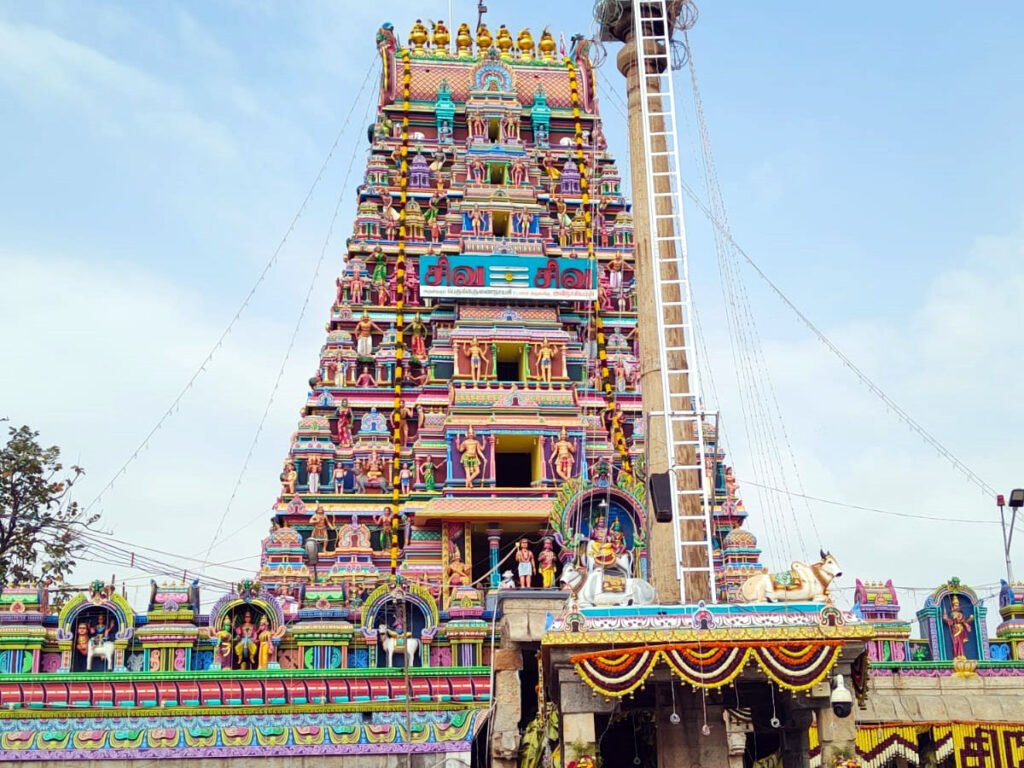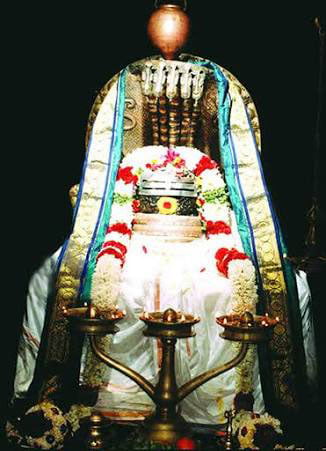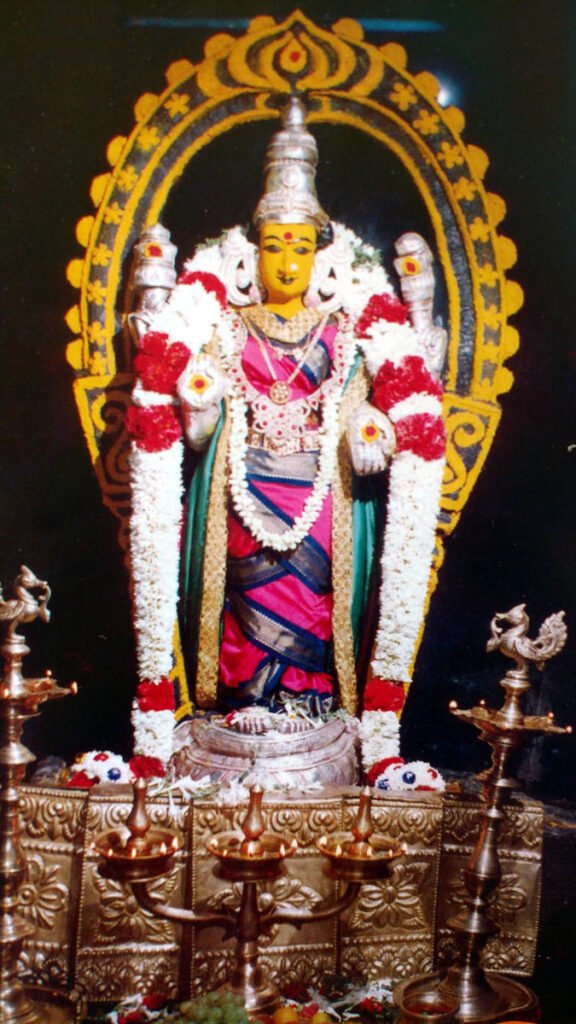Avinashi Temple of Arulmigu Avinashi Lingeswarar
The Avinashi Temple, also known as the Avinashilingeswarar Temple or Karunaiyaaththaal Temple, is a Hindu temple dedicated to the deity Shiva located in Avinashi, a panchayat town in Tiruppur district in the South Indian state of Tamil Nadu.

Contents
- 1 Avinashi Temple History:
- 2 Legend of Avinashi Lingeswarar Temple:
- 3 Significance of Avinashi Temple:
- 4 Myths of Avinashi Temple:
- 5 Avinashi Lingeshwarar Temple Architecture:
- 6 Avinashi Temple Timing and Rituals:
- 7 Places to visit near Avinashi Temple:
- 8 FAQ:
- 8.0.1 What is the Avinashi Lingeshwarar Temple?
- 8.0.2 What is the history of the temple?
- 8.0.3 What are the architectural features of the temple?
- 8.0.4 What are the festivals celebrated at the temple?
- 8.0.5 What are the temple timings?
- 8.0.6 How to reach the temple?
- 8.0.7 Is there a dress code for the temple?
- 8.0.8 Can I take photos inside the temple?
- 8.0.9 Where can I stay near the temple?
- 9 How to reach Avinashi Lingeshwarar Temple:
- 10 Google Maps:
Avinashi Temple History:
Ancient Origins:
- Though the exact date of construction remains unknown, estimations place it as far back as the Pallava dynasty (3rd-9th centuries CE).
- The temple’s original name, Tiruppukkozhiyur, translates to “a place of refuge” and hints at its possible historical significance as a sanctuary.
- Its current name, Avinashi, meaning “indestructible,” reflects the belief in the enduring power of the presiding deity, Lord Shiva.
Legends and Spiritual Importance:
- The temple finds mention in the 7th-century Tamil Saiva canonical work, Tevaram, composed by the Nayanar saints, solidifying its spiritual significance for centuries.
- A popular legend narrates how the saint Sundarar intervened to save a boy swallowed by a crocodile, showcasing the temple’s association with divine interventions.
- The temple is considered one of the seven Shivastalams of Kongunadu, a historic region encompassing parts of present-day Tamil Nadu.
Architectural and Cultural Significance:
- The temple architecture displays Dravidian influences, evident in its gopurams (ornate gateways), mandapas (halls), and sculptures.
- The temple houses various shrines dedicated to deities like Parvati, Bhairava, and Ganesha, enriching its cultural significance.
- Intricate murals and inscriptions adorn the temple walls, offering glimpses into its artistic heritage and past practices.
Modern Relevance:
- Today, the Avinashi Temple remains a crucial pilgrimage site for devotees across Tamil Nadu and beyond.
- It attracts worshippers seeking blessings for various aspects of life, including health, prosperity, and well-being.
- The temple undergoes regular renovations and cultural events, ensuring its continued relevance for future generations.
Further Exploration:
- To delve deeper, you can explore:
- The Archaeological Survey of India (ASI) website for information on protected monuments, potentially including the Avinashi Temple.
- Tamil Nadu tourism websites or local travel blogs for detailed descriptions and visuals of the temple.
- Academic articles or books on South Indian temple architecture and history for a deeper understanding of the context.
Read More>> Vajreshwari Temple Maharashtra

Legend of Avinashi Lingeswarar Temple:
1. The Legend of Sundarar and the Crocodile:
- This legend is linked to the 7th-century Tamil saint poet Sundarar.
- Two young boys were playing near a temple tank when a crocodile attacked and swallowed one of them.
- The boy’s distraught mother pleaded with Sundarar, who was passing by, to help.
- Deeply moved, Sundarar sang devotional hymns to Lord Shiva within the temple.
- Miraculously, the crocodile emerged from the tank and released the unharmed boy.
- This event solidified the temple’s reputation as a place of powerful blessings and divine intervention.
2. The Legend of Avinashi’s Indestructibility:
- The name “Avinashi” itself translates to “indestructible,” reflecting the temple’s association with Lord Shiva’s unwavering grace and protection.
- Legend tells of a time when powerful forces attempted to demolish the temple.
- However, their efforts were thwarted by miraculous interventions, preventing the temple from being destroyed.
- This further cemented the belief in Shiva’s presence and the temple’s enduring significance.
Read More>> Uthirakosamangai Temple of Arulmigu Mangaleswari Udanurai Mangalanatha Swamy

Significance of Avinashi Temple:
Religious Significance:
- Dedicated to Lord Shiva: The temple enshrines Lord Shiva, also known as Avinasiappar, represented by a lingam. He is worshipped for his immense power, grace, and ability to protect devotees.
- Paadal Petra Sthalam: It is classified as a “Paadal Petra Sthalam,” meaning it is revered in the 7th-century Tamil Saiva canonical work, “Tevaram,” composed by the Nayanar saints. This elevates its importance within the Shaiva tradition.
- Legends: Several legends are associated with the temple, adding to its mystical aura. One narrates how Saint Sundarar brought back a boy devoured by a crocodile through his hymns to Shiva. Another links its name “Avinashi” (meaning “indestructible”) to the protection offered by the deity.
Historical Significance:
- Ancient Origins: Though the exact date of construction is unknown, the temple’s history stretches back several centuries, possibly to the Pallava era (6th-9th centuries CE).
- Royal Patronage: The temple received patronage from various rulers, including the Cheras, Cholas, and Pandyas, indicating its importance in the region’s history.
- Architectural Heritage: The temple architecture showcases Dravidian styles with intricate carvings and sculptures, offering a glimpse into the artistry of past eras.
Cultural Significance:
- Local Landmark: The Avinashi Temple serves as a significant landmark for the town of Avinashi and the surrounding Tiruppur district, drawing devotees and tourists alike.
- Festivals and Traditions: The temple celebrates various festivals throughout the year, attracting large crowds and perpetuating local cultural traditions.
- Symbol of Community: The temple acts as a unifying factor for the community, fostering social interaction and religious gatherings.
Read More>> 8th Century Mahabalipuram Shore Temple

Myths of Avinashi Temple:
The Avinashi Temple, also known as the Avinashi Lingeshwarar Temple or Thirupukkoliyur Temple, boasts a rich tapestry of myths and legends deeply woven into its history and significance. Here are some of the most prominent ones:
1. Indestructible Avinashi: The name “Avinashi” itself translates to “indestructible,” reflecting a central myth. Legend states that Devas (celestial beings) once sought refuge in this temple from Asuras (demons). Shiva, the presiding deity, granted them protection, solidifying the belief that the temple and its devotees remain shielded from destruction.
2. Sundarar and the Crocodile: One of the most popular myths involves the 7th-century Tamil saint Sundarar. As the story goes, two young boys were bathing in the temple pond when a crocodile snatched one. The bereaved mother pleaded with Sundarar, who sang devotional hymns to Shiva. Miraculously, the crocodile emerged, releasing the unharmed boy, demonstrating Shiva’s power and grace.
3. Kashi within Avinashi: Another legend claims that the temple holds a connection to the holy city of Kashi (Varanasi). It’s believed that holy water from Kashi was brought to Avinashi, making it a sacred counterpart, hence the saying “Kasiyil Vasi Avinashi,” meaning “half the benefits of worshipping in Kashi can be attained in Avinashi.”
4. Blessings of Karunambikai: The temple also enshrines the goddess Karunambikai, known for her abundant compassion. Devotees believe she grants wishes, bestows blessings, and removes obstacles, further enhancing the temple’s spiritual significance.
5. Sacred Theerthams: The temple complex houses several sacred water bodies or “theerthams,” each carrying its own mythology. The “Kasi Kinaru” well is said to contain water directly from Kashi, while the “Naga Kanni Theertham” is associated with a mythical snake princess offering boons.
These are just a few of the many myths and legends surrounding the Avinashi Temple. It’s important to remember that these narratives are rooted in faith and tradition, passed down through generations, and serve to enrich the temple’s spiritual and cultural significance for devotees.
Read More>> 1500 Yrs Old Siruvapuri Murugan Temple

Avinashi Lingeshwarar Temple Architecture:
The temple is spread over an area of 1.5 acres and is known for its Dravidian style of architecture. The main entrance to the temple is on the east side and is adorned with a seven-tiered gopuram, or gateway tower. The gopuram is richly decorated with sculptures of Hindu deities and mythological figures.
Once inside the temple, there are two corridors that lead to the sanctum sanctorum, or the holiest part of the temple. The corridors are lined with pillars that are carved with intricate designs.
The sanctum sanctorum houses the lingam, which is the symbolic representation of Shiva. The lingam is made of black granite and is said to be self-manifested. There are several other shrines located within the temple complex, including shrines dedicated to Parvati, the consort of Shiva, Ganesha, the son of Shiva, and Subramanya, the war god.
The Avinashi Lingeshwarar Temple is an important pilgrimage site for Hindus and is known for its spiritual atmosphere. The temple is also a popular tourist destination and is known for its beautiful architecture and sculptures.
Read More>> Nambunayaki Amman Temple Rameswaram
Avinashi Temple Timing and Rituals:
Timings:
- The temple is open from 6:00 AM to 8:00 PM.
- The first puja is performed at 6:30 AM, and the last puja is performed at 7:30 PM.
- Aartis are performed at 6:30 AM, 12:00 PM, and 6:30 PM.
Rituals:
- Darshan: The main ritual is darshan, which means seeing the deity. Devotees can stand in the queue and take a few moments to pray to the deity.
- Abhishekam: This is a ritual where the deity is bathed with milk, water, panchamruta, and other sacred substances.
- Archana: This is a ritual where offerings of flowers, incense, and lamps are made to the deity.
- Deeparadanai: This is a ritual where lamps are lit in front of the deity.
Special pujas:
- On Mondays, a special puja is performed to Lord Shiva.
- On Fridays, a special puja is performed to Goddess Parvati.
- On Pradosham days, a special puja is performed to both Lord Shiva and Goddess Parvati.
Read More>> Thirunallar Temple of Sri Darbaranyeswara Swamy
Places to visit near Avinashi Temple:
- Tirupur: Known as the “Knitwear Capital of India,” Tirupur is a nearby city famous for its textile and garment industry. You can explore the local markets and witness the vibrant textile culture.
- Bhavani Sagar Dam: Located on the Bhavani River, this dam is a picturesque spot with serene surroundings. It’s a great place for a peaceful getaway and offers beautiful views of the dam and its surroundings.
- Kovai Kondattam Amusement Park: Situated in Coimbatore, which is not very far from Avinashi, this amusement park is a fun destination for families. It features water rides, dry rides, and various entertainment options.
- Perur Pateeswarar Temple: Another notable temple, the Perur Pateeswarar Temple is located in Coimbatore. It’s an ancient temple with a rich history and beautiful architecture.
- Dhyanalinga: Located in Isha Yoga Center, Coimbatore, Dhyanalinga is a unique meditative space that attracts people seeking spiritual experiences. The Isha Yoga Center itself is a serene place for those interested in yoga and spirituality.
- Marudamalai Murugan Temple: Situated on a hillock near Coimbatore, this temple is dedicated to Lord Murugan. The temple is known for its scenic location and is a popular pilgrimage site.
- Sri Naga Sai Mandir: Located in Coimbatore, this temple is dedicated to Lord Shirdi Sai Baba. It’s a serene place for devotees and offers a peaceful atmosphere for prayer and meditation.
- Arulmigu Patteeswarar Swamy Temple, Perur: Another ancient temple in Coimbatore, it is dedicated to Lord Shiva. The temple has intricate carvings and a peaceful ambiance.
FAQ:
What is the Avinashi Lingeshwarar Temple?
The Avinashi Lingeshwarar Temple is a Hindu temple dedicated to the deity Shiva, located in Avinasi, a panchayat town in Tiruppur district in the South Indian state of Tamil Nadu. Shiva is worshipped as Avinasiappar, and is represented by the lingam. His consort Parvati is depicted as Karunambigai.
What is the history of the temple?
The exact origins of the temple are unknown, but it is believed to be centuries old. The temple has been mentioned in several historical texts, including the Tamil epic Silappadhikaram.
What are the architectural features of the temple?
The temple is built in the Dravidian style of architecture. The main gopuram (gateway tower) is seven tiers tall and is adorned with intricate sculptures. The temple complex also includes several other shrines, halls, and mandapas (pavilions).
What are the festivals celebrated at the temple?
The temple celebrates several festivals throughout the year, including the Arudhra Darisanam, Shivaratri, and Navaratri.
What are the temple timings?
The temple is open from 6:00 AM to 12:00 PM and 4:00 PM to 8:00 PM.
How to reach the temple?
The temple is located in Avinasi, which is about 40 km from Coimbatore and 14 km from Tirupur. The nearest railway station is at Tirupur and the nearest airport is Coimbatore International Airport.
Is there a dress code for the temple?
Devotees are expected to dress modestly. Men should remove their shirts and dhotis should be worn below the knee. Women should wear sarees or salwar kameez.
Can I take photos inside the temple?
Photography is not allowed inside the sanctum sanctorum (innermost shrine) of the temple. However, photography is allowed in other areas of the temple complex.
Where can I stay near the temple?
There are several hotels and guesthouses located near the temple.
How to reach Avinashi Lingeshwarar Temple:
By Air: The nearest airport is Coimbatore International Airport (approximately 47 kilometers away). From the airport, you can hire a taxi or use public transportation to reach Avinashi.
By Train: The nearest railway station is Avinashi Railway Station itself, making it convenient for travelers. You can check the train schedules and book tickets to Avinashi.
By Road: If you are traveling by road, you can use buses or hire a taxi. Avinashi is well-connected by road, and you can reach the temple by taking a bus or driving.

One Comment